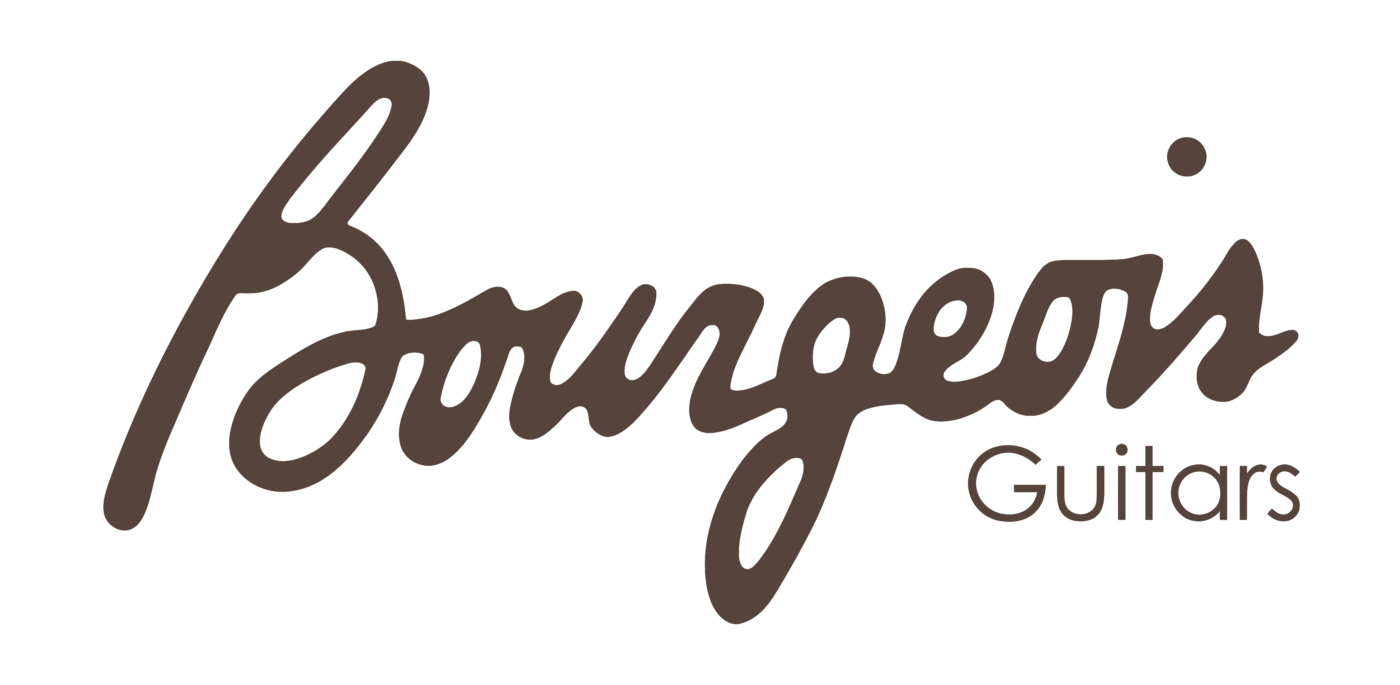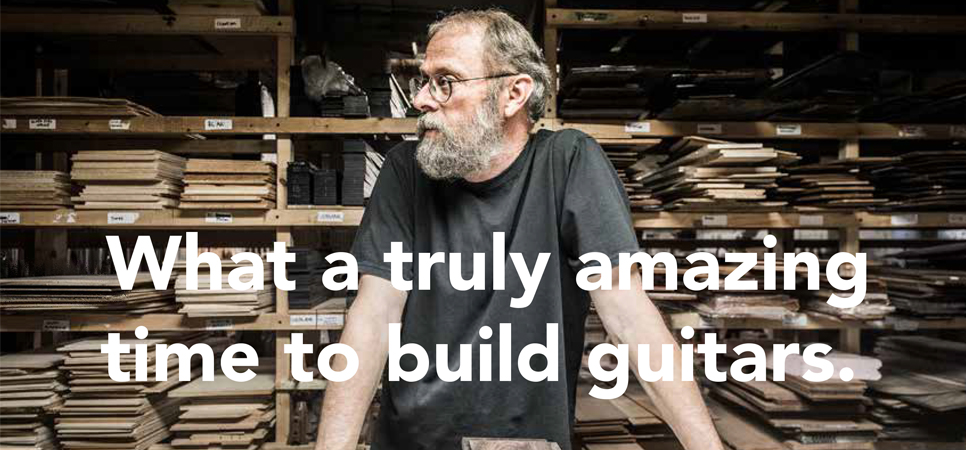Homepage News
“What a Truly Amazing Time To Build Guitars”
by Dana Bourgeois
In January of 1964, I saw The Beatles on the Ed Sullivan Show and had to have a guitar. Fortunate-ly for my future profession, I wasn’t alone. In my hometown and across the nation, platoons of kids persuaded parents to bring home all varieties of no-name electrics and acoustics: Silvertones, Teis-co Del Ray’s, Guilds, and even a few Martins and Gibsons. The movement was on. Offspring of the Greatest Generation set about learning chords and riffs, blistering fingers, trading songs, forming garage bands and consuming all forms of popu-lar music. The guitar became my video game, at times forcing my parents to stage interventions just to get me outdoors. Looking back, I was never an accomplished player. But I was always a serious player. Guitar was fun, and it allowed me to occa-sionally hang with the cool kids.
My first attempts at lutherie consisted of drawing miniature Fenders, Gibsons, Rickenbackers, Hoff-ner basses, etc., on little plywood paddle boards, cutting the outlines on my dad’s bandsaw and painting relatively accurate details with model air-plane enamels. My dad removed and hid electrical fuses to prevent us kids from using his power tools. I figured out how to hack the bandsaw by removing the guards and persuading my brother to turn the wheels by hand. He’d get up a head of steam while I steered the cuts, one-eighth of an inch at a time, until the blade literally ground to a halt. When I started building real guitars, there were no guitar schools and certainly no Google and YouTube.
I knew of only one practicing luthier, Nick Apollonio, who lived a couple hours away (and, btw, is still going strong). I had access to a couple books on the subject, but the methods they re-vealed were either hopelessly unreliable (“boil the sides in a tub of water, tie them to the mold with string”), or hopelessly unachievable (“your milling machine is the best tool for cutting saddle slots”). Somehow I persevered, making and even selling a guitar here and there. In retrospect, it’s amazing what a little passion and determination can accomplish.
In the mid-seventies popular music roared to a crescendo. Local bands played everywhere, and the guitar was more popular than ever. Handmade guitars didn’t yet pay the bills. All those Guilds, Hummingbirds and D-35s that kids my age took to college eventually needed maintenance, and at one point or another many found their way to my workbench. Having no local competition, I could make a pretty good living producing what I now know to be mediocre work. Back then, de-cent apartments went for $300/month and a re-fret brought in $75. So glad I’m not starting out now.
Along the way I began to meet a few pros whose work, depth of experience and business models rocked my little world. Through the Whole Earth Catalogue I learned that Michael Gurian ran what would now be called a boutique production shop, in Hinsdale, NH.
I made quite a few round trip, eight-hour drives to Hinsdale for the privilege of selecting and purchasing tonewoods, getting my first peeks at a real guitar operation, and receiving occasional words of wisdom from someone who knew a lot more than I did. Walter Lipton built steel string and classical guitars in Orford, NH, and also sold wood. And Michael Cone built world class classical guitars, using only hand tools, in an off-grid house in New Vinyard, Maine. Michael turned me on to the Guild of American Luthiers. I became a member and attended their 1979 convention in Boston, where I met John Monteleone, Steve Klein and David Russel Young. Wow. By the time the 80s rolled around, I had saturated my southern Maine market. I needed either to project my services to a bigger community or relocate from the area my ancestors had settled back in the mid-eighteenth century. Fortunately, I didn’t relocate. The Big Time came to me when I met Eric Schoenberg and began repairing and restor-ing real vintage guitars from his personal collection and from The Music Emporium, the shop he co-owned in Cambridge, MA. The first half of the de-cade was spent making bi-weekly or monthly treks to Cambridge to pick up and drop off repair work. Soon I and my apprentice, TJ Thompson, had a serious backlog of vintage repair and restoration work.During those Boston trips I got to meet and later know a few of my acous-tic guitar heroes, including Russ Barenberg, Tony Rice, Norman Blake and Doc Watson. More importantly, I got to hear them play guitars I had built. The ideal I strove for, and still do, was the sound of a truly great vintage guitar in the hands of a great player. In no way is that actually possible to achieve…probably ever, and certainly not back then. But it’s good to have standards and even better to
understand exactly how one measures up to them. Tony Rice once told me, “This guitar doesn’t quite make it, man.” Though I still wince at the recol-lection, Tony’s unique brand of kindness and honesty probably was, in the big picture, at least as valuable as the last couple digits on my right hand. In the mid-eighties, Eric asked Chris Martin if C.F. Martin’s new Custom Shop would build a guitar along the lines of a cutaway OM I had by that time developed. Chris answered that it wasn’t anything they’d consider building under the Martin name. And that’s how Schoenberg Guitars was born, with me as a founding co-partner. For a few years I selected wood, made specialty parts, and voiced guitars at the Martin factory like it was no big deal. Based on my Schoenberg Guitars experience, I later got a gig with Gibson as a pro-cess design consultant, helping the company open an acous-tic guitar factory in Bozeman, Montana. Then I got hired by PRS to help develop a business plan and product line for an acoustic guitar division.
Around the dawn of the 90s, Paul had decided that he wasn’t yet ready for acoustics and I was on my own again. That decade flew by. After spending two years planning someone else’s acoustic guitar venture, having a go on my own seemed like the natural next thing to do. The time was right. By the early 90s, many of the kids I grew up and went to college with found them-selves living in better neighbor-hoods and rediscovering the guitar as a quality, leisure-time experience. Santa Cruz and Collings emerged as premium brands. The “acoustic boutique” retail support model, the ease of small package shipping pioneered by UPS and FedEx, and, moreover, the emergence of the internet—all helped pave direct paths between my fledgling business and The Market. I distinctly remember blowing away a couple of my dealers after transforming a three-fold brochure into a website. Most significantly for the shape of my new business model, I had seen CNC technology out in the Big World. Tom Anderson and Bob Taylor were early pioneers.
I determined not to lag far behind. I remember the skepticism of some dealers and customers, who, early on, couldn’t quite understand that properly deployed CNC technology actually enhances product quality and in no way corrupts the “handmade” ideal. These days, dozens and dozens of individual luthiers incorporate CNC-pro-duced components in the building of their indisputably handmade guitars. Hand saws, power saws, and CNC mills, it turns out, are equally incapable of producing quality product in the absence of superior design and highly skilled operation.
Much of the going was, and still can be, rough. I learned the hard way not to run a business on credit cards, not to pledge your house as collateral for a business loan, not to hire close friends, relatives or anyone expecting lifetime job security. I learned that locally hired employees tend to stick around longer than someone who’s willing to drive across the country to start work in the spring but doesn’t own a pair of winter boots. And I learned that high-level skill in any craft can be a better qualification for production guitar work than con-siderable lutherie experience, if accompanied by intelligence, character, positive attitude and excellent communication skills. The learning curve has yet to flatten. Twenty-five years and three production shops later, I’m still making expensive sawdust. Bourgeois Guitars now has eighteen employees and produces about four hundred guitars in a good year.
We recently moved to a newly renovated 8,000 square foot facility in an 1880s Lewiston, Maine, textile mill. I hope this was my last relocation. (Hold me to it…please!) Though my title is CEO, I still spend the lion’s share of my time working in the shop. When I’m not in management meetings or on the road at promotional events, I select wood, voice tops and backs, inspect guitars at various stages of construction and upon completion, work on prototypes and new tooling, and sometimes empty the trash. My medium-range goals are the continual optimization of workplace culture to promote and reward teamwork, and the maintenance of consis-tent quality standards across diverse combinations of body styles, tonewoods and price points. My long-term goal is figuring out how the hell to retire.
Let me repeat, this has been a truly amazing time to build guitars. The common thread running through my entire career is the seemingly mirac-ulous opening of doors, precisely at times when entrances and exits made a difference. Along the way I was often smart enough to recognize oppor-tunities when I saw them. Hard work, a little talent and an ability to learn from mistakes helped a lot. Someone once said that eighty percent of success is showing up. And that may be right. I’d be a fool, however, not to acknowledge just how lucky I’ve also been. I was lucky to be born into a generation that adores guitar music and guitars. I was lucky to begin my career at a time when iconic American guitar manufacturers produced products of historically low quality. I was lucky to enjoy a peer network of truly great luthiers, many of whom loved nothing better than talking shop. I was lucky to have just enough skills to take advantage of the moment when older used guitars began a historic transformation into vintage guitars. I was lucky to get to know some of the greatest acoustic guitarists of the American Roots genre. I was lucky to experience a taste of the corporate guitar world just at a time when old-line companies began to feel the need for new blood. I was lucky to launch a business at a time when emerging technologies brought certain advantages to early adopters. And I was lucky to enjoy a forty-plus year marriage to a wonderful wife (with a good job), who supported me through numerous bumpy patches.
Most of all, I was lucky to find a way to follow my passion for music, guitars, and the joys these gifts bring to so many people.

